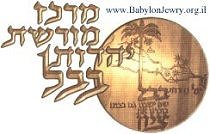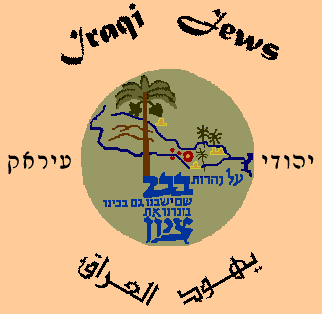Arab journalist laments state of Ezekiel’s tomb
Point of no return
02/25/2011
By Mazan Latif for As-Sabaah Iraqi daily newspaper
[caption id="" align="alignnone" width="368" caption="Jews at Tomb of Ezekiel in the 1930's"] [/caption]
Lately, a lot has been said about the shrine of Kefel or what is called by the Jews 'the shrine of the Prophet Ezekiel.'
The shrine is of great importance to all Jews, but in particular to the Jews of Iraq to whom ownership was given by the Ottoman Sultan Abdel Hamid.
The Jews used to visit the site yearly to pray and hold big celebrations. They used to slaughter and distribute the meat to the poor. The men in charge and the rabbis used to pray daily there until the mass exodus of the Jews from Iraq in 1951.
The village of Kefel is situated about 20 miles south of the town Hilla. In the Kefel is buried the Prophet Ezekiel z"l. The prophet Ezekiel is said to be a Cohen (descendant of the High Priest) from Jerusalem. Another seven Cohanim are buried there.
According to the Jews, the Prophet Ezekiel is mentioned in the Torah. The tomb of Ezekiel used to be covered with an expensive carpet and a hand-embroidered cloth. King Yehoyachin built a fence around the tomb with the help of many Jews.
The Jews bought the land near the shrine where they built a market and houses to be used by the Jewish guardians of the shrine and by the Rabbis in charge.
In 1860, the Muslims claimed the shrine and all the buildings around it for themselves. With the help of the Daniel family and and after many inquiries to Istanbul, the Ottoman authorities decided that the shrine belonged to the Jews and that the minaret did not belong to a mosque as the Muslims claimed.
The Muslim story claimed that the Prophet is an Arabic prophet descended from the Prophet Isma'el (Yishma'el). They lost their claim.
The Muslims from Hilla visit and pray in Kefel as they believe that the Prophet is a great one and mentioned in the Koran.
The minaret of the shrine is in a very bad condition and is supported by wooden poles to prevent it from falling.
The Jews used to own large libraries in their homes. When an owner died, all his books went to the Kefel library. After the mass exodus in 1951, all the books were kept in wooden boxes and covered with bricks. In the Seventies, someone destroyed all the boxes and the Hebrew books were scattered in the streets. As for the marble tablets that decorated the walls with the Hebrew inscriptions, they were stolen and sold to collectors who are interested in Jewish art.
Lately, after my visit in 2010 to the site, unfortunately what I saw was heartbreaking. Most of the Hebrew writings on the walls were erased. The tomb of Daniel was also in bad condition as well as the tombs of members of his family.
I did not see anything indicating that the site had a mosque or any sign of a Muslim site.
Unfortunately the Jewish shrine is in a very bad shape. Also there was no sign of the Sefer Torah the Jews used to pray with.
I am writing what my conscience dictates. I pray for a free Iraq true to its motto (Religion for God and the Homeland for all).
I ask the President of Iraq, the government, and all the people in charge to look after and preserve Iraq's true heritage.
Mazin Latif is an active Baghdadi journalist and writer specialising in Iraqi Jewish affairs. The article was summarised by Mrs. Eileen Khalastchy of London from an article in the As-Sabaah Iraqi daily newspaper ( Iraqi Information Net 13 February, 2011) http://www.alsabaah.com
View article hereJune 14, 2011Posted on
[/caption]
Lately, a lot has been said about the shrine of Kefel or what is called by the Jews 'the shrine of the Prophet Ezekiel.'
The shrine is of great importance to all Jews, but in particular to the Jews of Iraq to whom ownership was given by the Ottoman Sultan Abdel Hamid.
The Jews used to visit the site yearly to pray and hold big celebrations. They used to slaughter and distribute the meat to the poor. The men in charge and the rabbis used to pray daily there until the mass exodus of the Jews from Iraq in 1951.
The village of Kefel is situated about 20 miles south of the town Hilla. In the Kefel is buried the Prophet Ezekiel z"l. The prophet Ezekiel is said to be a Cohen (descendant of the High Priest) from Jerusalem. Another seven Cohanim are buried there.
According to the Jews, the Prophet Ezekiel is mentioned in the Torah. The tomb of Ezekiel used to be covered with an expensive carpet and a hand-embroidered cloth. King Yehoyachin built a fence around the tomb with the help of many Jews.
The Jews bought the land near the shrine where they built a market and houses to be used by the Jewish guardians of the shrine and by the Rabbis in charge.
In 1860, the Muslims claimed the shrine and all the buildings around it for themselves. With the help of the Daniel family and and after many inquiries to Istanbul, the Ottoman authorities decided that the shrine belonged to the Jews and that the minaret did not belong to a mosque as the Muslims claimed.
The Muslim story claimed that the Prophet is an Arabic prophet descended from the Prophet Isma'el (Yishma'el). They lost their claim.
The Muslims from Hilla visit and pray in Kefel as they believe that the Prophet is a great one and mentioned in the Koran.
The minaret of the shrine is in a very bad condition and is supported by wooden poles to prevent it from falling.
The Jews used to own large libraries in their homes. When an owner died, all his books went to the Kefel library. After the mass exodus in 1951, all the books were kept in wooden boxes and covered with bricks. In the Seventies, someone destroyed all the boxes and the Hebrew books were scattered in the streets. As for the marble tablets that decorated the walls with the Hebrew inscriptions, they were stolen and sold to collectors who are interested in Jewish art.
Lately, after my visit in 2010 to the site, unfortunately what I saw was heartbreaking. Most of the Hebrew writings on the walls were erased. The tomb of Daniel was also in bad condition as well as the tombs of members of his family.
I did not see anything indicating that the site had a mosque or any sign of a Muslim site.
Unfortunately the Jewish shrine is in a very bad shape. Also there was no sign of the Sefer Torah the Jews used to pray with.
I am writing what my conscience dictates. I pray for a free Iraq true to its motto (Religion for God and the Homeland for all).
I ask the President of Iraq, the government, and all the people in charge to look after and preserve Iraq's true heritage.
Mazin Latif is an active Baghdadi journalist and writer specialising in Iraqi Jewish affairs. The article was summarised by Mrs. Eileen Khalastchy of London from an article in the As-Sabaah Iraqi daily newspaper ( Iraqi Information Net 13 February, 2011) http://www.alsabaah.com
View article hereJune 14, 2011Posted on
Point of no return
02/25/2011
By Mazan Latif for As-Sabaah Iraqi daily newspaper

Jews at Tomb of Ezekiel in the 1930's
Lately, a lot has been said about the shrine of Kefel or what is called by the Jews ‘the shrine of the Prophet Ezekiel.’
The shrine is of great importance to all Jews, but in particular to the Jews of Iraq to whom ownership was given by the Ottoman Sultan Abdel Hamid.
The Jews used to visit the site yearly to pray and hold big celebrations. They used to slaughter and distribute the meat to the poor. The men in charge and the rabbis used to pray daily there until the mass exodus of the Jews from Iraq in 1951.
The village of Kefel is situated about 20 miles south of the town Hilla. In the Kefel is buried the Prophet Ezekiel z”l. The prophet Ezekiel is said to be a Cohen (descendant of the High Priest) from Jerusalem. Another seven Cohanim are buried there.
According to the Jews, the Prophet Ezekiel is mentioned in the Torah. The tomb of Ezekiel used to be covered with an expensive carpet and a hand-embroidered cloth. King Yehoyachin built a fence around the tomb with the help of many Jews.
The Jews bought the land near the shrine where they built a market and houses to be used by the Jewish guardians of the shrine and by the Rabbis in charge.
In 1860, the Muslims claimed the shrine and all the buildings around it for themselves. With the help of the Daniel family and and after many inquiries to Istanbul, the Ottoman authorities decided that the shrine belonged to the Jews and that the minaret did not belong to a mosque as the Muslims claimed.
The Muslim story claimed that the Prophet is an Arabic prophet descended from the Prophet Isma’el (Yishma’el). They lost their claim.
The Muslims from Hilla visit and pray in Kefel as they believe that the Prophet is a great one and mentioned in the Koran.
The minaret of the shrine is in a very bad condition and is supported by wooden poles to prevent it from falling.
The Jews used to own large libraries in their homes. When an owner died, all his books went to the Kefel library. After the mass exodus in 1951, all the books were kept in wooden boxes and covered with bricks. In the Seventies, someone destroyed all the boxes and the Hebrew books were scattered in the streets. As for the marble tablets that decorated the walls with the Hebrew inscriptions, they were stolen and sold to collectors who are interested in Jewish art.
Lately, after my visit in 2010 to the site, unfortunately what I saw was heartbreaking. Most of the Hebrew writings on the walls were erased. The tomb of Daniel was also in bad condition as well as the tombs of members of his family.
I did not see anything indicating that the site had a mosque or any sign of a Muslim site.
Unfortunately the Jewish shrine is in a very bad shape. Also there was no sign of the Sefer Torah the Jews used to pray with.
I am writing what my conscience dictates. I pray for a free Iraq true to its motto (Religion for God and the Homeland for all).
I ask the President of Iraq, the government, and all the people in charge to look after and preserve Iraq’s true heritage.
Mazin Latif is an active Baghdadi journalist and writer specialising in Iraqi Jewish affairs. The article was summarised by Mrs. Eileen Khalastchy of London from an article in the As-Sabaah Iraqi daily newspaper ( Iraqi Information Net 13 February, 2011) http://www.alsabaah.com
View article here




